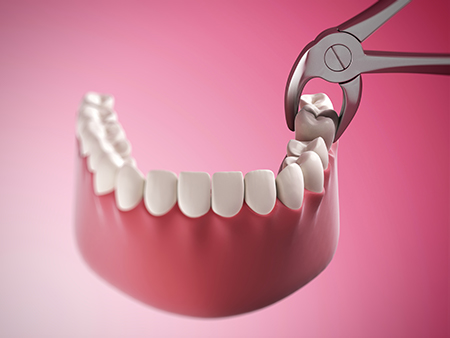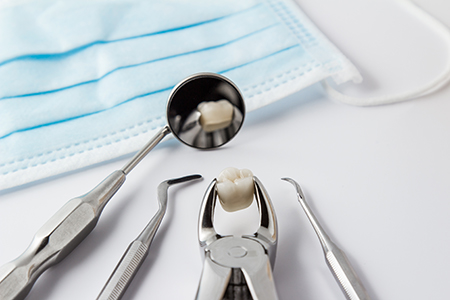Call Us Today!
(248) 863-9109
New Patients
(248) 221-2314

At the office of Royal Dental Center, patient comfort and long-term oral health guide every recommendation. Removing a tooth is never our first option—our team evaluates whether restorative treatments can preserve the natural tooth before advising extraction. When removal is the safest path forward, we explain the reasons clearly and outline what to expect at each step.
Tooth extraction can protect your overall health by removing sources of infection, preventing damage to neighboring teeth, and helping create the right conditions for orthodontic or prosthetic treatment. We balance clinical judgment with an individualized care plan so each patient understands why an extraction is recommended and how it fits into their broader treatment goals.
Our approach combines experience, modern diagnostics, and patient-focused communication. We’ll review your medical history, examine the area, and use imaging to make a clear diagnosis. If extraction is indicated, we’ll discuss pain control options, the likely type of procedure, and the timeline for healing and any necessary follow-up care.
Persistent baby (deciduous) teeth that block eruption
Sometimes a primary tooth does not fall out when expected because its roots fail to resorb or it becomes fused to the jawbone. An over-retained baby tooth can interfere with the eruption and alignment of permanent teeth. When monitoring shows that removal will prevent misalignment or other complications, extraction is performed with care to protect the developing dentition.
Severe decay that destroys tooth structure
Dental decay can progress from a small enamel lesion into extensive structural loss and nerve involvement. When a tooth cannot be restored reliably—either because too much supporting structure is gone or the root is compromised—removal becomes the safest option to eliminate infection and protect surrounding teeth and tissues.
Teeth fractured beyond repair
Cracks and fractures vary widely in severity. When a break extends below the gumline, involves the root, or leaves insufficient tooth for a crown or filling, extraction may be the most predictable way to resolve pain and restore function using replacement options later.
Advanced periodontal disease
When gum disease has severely damaged the bone and soft tissues that support teeth, affected teeth may loosen and become a source of chronic infection. Removing teeth that jeopardize overall oral health can halt progression and make it possible to restore function with prosthetic or implant solutions once the mouth is stable.
Wisdom teeth that are impacted, poorly positioned, or decayed
Third molars often lack room to erupt properly, leading to impaction, recurrent decay, or pressure on adjacent teeth. In many younger adults, preventive removal of problematic wisdom teeth reduces the risk of future complications and protects the surrounding dentition.
Extractions as part of orthodontic planning
When jaw dimensions can’t accommodate all permanent teeth, removing selected teeth is sometimes the most effective way to create space for alignment and bite correction. Extractions for orthodontics are planned in collaboration with your orthodontist to achieve a balanced, functional result.

Every extraction begins with a careful evaluation that considers your overall health, dental history, and the specific condition of the tooth. We ask about medications and medical conditions that could affect healing, and we take appropriate imaging to assess root shape, bone levels, and proximity to critical structures. This preparation helps us choose the safest, least invasive method.
Open communication is a priority. We explain the recommended procedure, the expected level of discomfort, and the steps we take to manage pain and anxiety. For patients with particular concerns—such as medical conditions that require coordination with a physician or increased anxiety about dental treatment—we tailor the plan to those needs and discuss available sedation options.
Imaging—most commonly digital radiographs—allows us to visualize root anatomy and the surrounding bone. That information guides whether a tooth is likely to be removed easily in one piece or whether a more involved surgical approach might be necessary. We also review post-extraction options for replacement so you understand the next steps for restoring function and appearance.
Simple extractions are performed when a tooth is visible in the mouth and the root anatomy is straightforward. After numbing the area thoroughly with local anesthesia, the dentist gently loosens the supporting tissues and uses forceps to remove the tooth. The technique is quick and focused on minimizing trauma to the surrounding bone and soft tissues.
Most patients feel only pressure during the procedure, and routine measures are used to keep you comfortable throughout. We provide clear aftercare instructions and schedule follow-up when needed so healing can be monitored and any concerns addressed promptly.
Surgical extractions are required for teeth that are broken at the gumline, impacted, ankylosed, or otherwise difficult to access. These procedures may involve a small incision in the gum and, when necessary, the careful removal of a small amount of bone to free the tooth. Because surgical extractions are more involved, they are planned carefully and performed with extra attention to pain control and healing.
We sometimes refer complex cases to an oral and maxillofacial surgeon when specialized surgical access is needed. Whether performed in our office or by a specialist, patients receive full explanations of the procedure, anesthesia options, and post-operative care tailored to the complexity of the extraction.

Recovery after extraction is typically straightforward when you follow a few key guidelines. Immediately after the procedure, controlled pressure over the site helps a blood clot form—this clot is a vital part of natural healing. We provide instructions for gauze use and what to expect in the first 24–48 hours so you can be confident about the normal course of recovery.
Managing discomfort is an important part of recovery. Taking recommended medications on schedule, applying cold packs intermittently during the first day, and resting as needed all support a smoother healing process. We emphasize avoiding behaviors that might dislodge the clot—such as spitting, drinking through a straw, or vigorous rinsing—until the site has stabilized.
Good oral hygiene supports healing but must be balanced with protecting the surgical site. Gentle brushing away from the extraction area and light saltwater rinses as directed help keep the mouth clean without disturbing the clot. We provide specific instructions tailored to each patient’s situation, including when to resume normal oral care routines.
Maintain gauze pressure
Bite gently on the gauze placed over the extraction site to help the clot form. Replace the gauze as directed, and if bleeding persists beyond light oozing, follow the instructions we provide or contact us for guidance.
Protect numb tissues
Avoid chewing, touching, or biting the lips, cheeks, or tongue until the local anesthetic has fully worn off to prevent accidental injury.
Follow medication guidance
If antibiotics are prescribed, take them for the full course. For pain control, take over-the-counter or prescribed medications as advised to stay ahead of discomfort.
Avoid disturbing the clot
Do not rinse forcefully, use a straw, or smoke for several days. These actions can dislodge the healing clot and delay recovery.
Control swelling
Apply an ice pack to the outside of the face in short intervals on the day of surgery to reduce swelling and discomfort.
Choose easy-to-chew foods
Stick to soft, cool or lukewarm foods for the first few days. Hydrate well, and avoid alcohol or carbonated beverages until healing is underway.
Keep the mouth clean
Resume gentle brushing and use saltwater rinses as recommended to keep the area clean while avoiding any action that could disturb the extraction site.
Attend follow-up appointments
If stitches were placed or if your case requires monitoring, keep scheduled visits so we can confirm proper healing and address any concerns promptly.
If you experience heavy bleeding, increasing pain, swelling that worsens after a few days, or any unusual symptoms, contact our office for assessment and guidance.

When a tooth is removed, many patients wonder about the long-term plan for function and appearance. After healing, we review appropriate replacement options such as dentures, fixed bridges, or dental implants. Each option has advantages depending on the number of missing teeth, bone health, and your personal goals for stability and aesthetics.
Dental implants are often recommended when a permanent, natural-feeling solution is desired; they help preserve bone and provide excellent support for crowns or bridges. Fixed bridges remain a reliable choice when implants are not suitable, and partial or full dentures can restore function for a broader span of missing teeth. We discuss these choices openly so you can make an informed decision that fits your lifestyle and oral health.
Choosing our team means you’ll receive thoughtful, evidence-based care from providers who prioritize predictable outcomes and patient comfort. We coordinate with specialists when necessary and build a step-by-step plan that moves from extraction to restoration with clear milestones and compassionate support. For more information about extractions or to discuss your situation confidentially, please contact us for guidance and next steps.
The most common reasons for tooth loss include advanced periodontal disease, extensive tooth decay, and facial trauma. According to statistics, gum disease is responsible for close to 70% of tooth loss in adults. Although less frequent than the preceding three reasons, it should also be noted that specific diseases, drugs, smoking, and poor nutrition contribute to the risk of tooth loss.
The Centers for Disease Control and Prevention report that in the United States, an average of 12 teeth (including the wisdom teeth) are lost by the age of 50. Also, 26% of adults between 65 and 74 years of age have lost all their teeth.
Every patient and every situation is different. However, when a tooth and the surrounding tissues are numbed with a local anesthetic, you should only expect to feel a bit of pressure, but no pain as the tooth is being loosened from the surrounding tissues and extracted. For patients who are apprehensive and for some surgical extractions, our office will discuss our options in dental sedation to provide further relaxation and reduce any sense of discomfort.
While it's normal to feel some tenderness and swelling following an extraction, the degree of these sensations can vary. It mostly depends on the complexity of the extraction and the body's response to the procedure. We'll recommend or prescribe the appropriate pain medication to help ensure your comfort and give you specific instructions for maximum effectiveness and safety.
Typically, the recovery period following a simple extraction is shorter than a surgical extraction. However, a patient's overall health, habits, the size and location of the tooth, and other variables can influence recovery and healing. To speed up the recovery and avoid any complications, patients must follow the given at-home instructions diligently. We'll carefully review what to expect following your procedure and go over your post-op instructions.
Smoking interferes with blood clot formation, which is an essential first step in the healing process. Blood clot formation not only provides a protective layer to cover the underlying exposed bone and nerve endings, but it also supports the growth of new tissue. Cigarette smoke also contains chemical toxins that can disrupt the healing process and lead to problems such as continued inflammation, infection, or dry socket.
In a very small percentage of cases, a condition known as dry socket can develop in the aftermath of a dental extraction. This painful condition can arise when the blood clot in the extraction site doesn't form properly or gets dislodged. With dry socket, you may experience throbbing pain and symptoms such as bad breath and an unpleasant taste in your mouth. As skilled providers of care, our office will provide immediate treatment to alleviate your discomfort and promote healing.
The last teeth in your mouth to develop, wisdom teeth often do not have enough room to fully erupt or may be positioned in the wrong direction. These issues can affect your dental health as well as overall wellbeing. While some individuals never develop all their wisdom teeth, and a few have sufficient space for them, there are many people with partially or fully impacted third molars. Our office will monitor the development, position, and health of your wisdom teeth and will advise you if and when extractions are indicated.
After a tooth is removed, bone-grafting material is sometimes placed in the socket to promote healing and encourage new bone development. This procedure is often performed to support the eventual and successful placement of a dental implant.
At the office of Royal Dental Center, we strive to make dental care affordable and accessible. Depending on the type or complexity of the extraction and other variables, the cost of the procedure can vary. Based on our diagnostic findings, our office will inform you of the healthiest choices in care, explain the fees, discuss insurance coverage, and explain your payment options.
Many dental plans offer some level of coverage for tooth extractions. We'll advise you if your plan covers the full cost of the procedure and if there is any out-of-pocket expense. Our business office will work with you to maximize your insurance benefits as much as possible while helping you minimize any out-of-pocket expenses.
Tooth extraction may be recommended when a tooth is severely decayed, fractured beyond repair, or infected in a way that cannot be resolved with root canal therapy. Impacted or poorly positioned wisdom teeth, persistent baby teeth that block permanent teeth, and teeth that contribute to severe periodontal disease are also common reasons for extraction. Extractions are considered when removing a tooth is the safest way to protect your overall oral health and prevent the spread of infection.
Before recommending an extraction, the dentist evaluates the tooth with a clinical exam and radiographs to determine whether restoration is possible. When conservative treatments are not feasible or would jeopardize neighboring teeth, extraction becomes the most predictable option. The goal is always to preserve natural teeth when possible while prioritizing the patient’s long-term oral health.
A simple extraction is performed on a tooth that is visible above the gum line and can be removed using elevators and forceps after the area is numbed with local anesthesia. These procedures are typically straightforward and completed in a single appointment with minimal soft-tissue manipulation. Simple extractions are common for teeth that have sufficient structure for the dentist to grasp and remove without needing to cut tissue or bone.
Surgical extractions are required when a tooth is broken, impacted, ankylosed, or when the root anatomy is irregular and not easily accessible. Surgical procedures may involve a small incision in the gum, removal of a portion of supporting bone, and sometimes sectioning the tooth into pieces to facilitate safe removal. Complex cases may be referred to an oral and maxillofacial surgeon for treatment under different sedation or anesthesia options.
Both types of extraction include a preoperative assessment and postoperative instructions to support healing and reduce the risk of complications. The choice between a simple and surgical approach depends on the tooth’s position, root form, surrounding bone, and overall medical considerations. Your dentist will explain the recommended approach and answer questions about what to expect before, during, and after the procedure.
Preparation begins with a thorough review of your medical and dental history, including current medications, allergies, and any chronic conditions such as diabetes or bleeding disorders. Bring a list of medications to your appointment and share any recent changes in health, including respiratory or viral symptoms. Some patients require antibiotic premedication or medical clearance from their physician, especially when systemic health issues are present.
On the day of surgery follow any instructions provided by the office, such as fasting if sedation is planned, and arrange for someone to drive you home if necessary. Wear comfortable, loose clothing and avoid strenuous activity before the procedure. Clear communication with your dental team about your anxiety level and past experiences with dental care helps them tailor pain control and sedation options to keep you comfortable.
Local anesthesia is the most common option and provides numbness of the tooth and surrounding tissues so the procedure is painless. For patients who feel anxious or require more complex surgical care, additional sedation options may be offered, such as nitrous oxide (laughing gas) or oral conscious sedation. These options help reduce anxiety while allowing the patient to remain responsive and recover quickly after the appointment.
For more involved surgical extractions, especially impacted wisdom teeth or cases managed by an oral surgeon, intravenous (IV) sedation or general anesthesia may be used to provide deeper levels of comfort and amnesia. Your dentist or surgeon will review the risks and benefits of each option and coordinate care with your medical history, ensuring appropriate monitoring during and after the procedure. Clear instructions about fasting and transportation are essential when deeper sedation is planned.
Immediately after extraction you will bite on gauze to help form a blood clot at the site; some bleeding and oozing for the first 24 hours is normal. Swelling typically peaks within the first 48 hours and can be controlled with intermittent ice application and elevation of the head. Pain can usually be managed with over-the-counter analgesics or prescribed medications when indicated, and most patients experience significant improvement within a few days.
To support healing avoid rinsing forcefully, using a straw, smoking, or spitting vigorously for the first 24 to 48 hours as these actions can dislodge the clot and lead to complications. Stick to soft, cool or lukewarm foods for several days and gradually return to your normal diet as comfort allows. Maintain gentle oral hygiene around the extraction site, and begin saltwater rinses after the first 24 hours if advised to keep the area clean without disturbing healing tissue.
Follow-up care may include suture removal or a postoperative check to verify healing and address any concerns. Most soft tissue healing occurs within one to two weeks, while the underlying bone remodels over several months. If a tooth replacement is planned, your provider will discuss timing and options once initial healing is underway.
Common complications include prolonged bleeding, dry socket (a painful condition where the clot is dislodged), infection, and temporary numbness if a nearby nerve was irritated. Some postoperative swelling and minor bruising are expected, but intense or worsening pain, fever, or purulent drainage can indicate an infection that needs prompt attention. Persistent or heavy bleeding beyond what was anticipated should be reported immediately so the team can advise or provide urgent care.
Contact the office if you experience increasing pain after the initial 48 to 72 hours, uncontrolled bleeding despite applying pressure, signs of systemic infection such as fever, or new numbness that does not improve. If you were given specific emergency instructions or a contact number, use that resource for after-hours concerns. In situations where swelling affects breathing or swallowing, seek emergency medical care right away.
Yes, a missing tooth can typically be replaced, and options include dental implants, fixed bridges, and removable dentures depending on the location, patient health, and bone support. Dental implants are often recommended for single-tooth replacement because they preserve adjacent teeth and help maintain jawbone volume. Fixed bridges may be appropriate when neighboring teeth can serve as reliable support, and removable dentures are a noninvasive option for replacing multiple teeth.
Dental implants require careful planning, sufficient bone volume, and a healing period before final restoration, although immediate placement is possible in select cases. Each option carries different advantages and clinical considerations, and your dentist will explain which approach best meets your functional and aesthetic goals. A personalized treatment plan will consider overall health, oral hygiene, and long-term maintenance to achieve a predictable outcome.
Your provider at Royal Dental Center in West Bloomfield, MI, can review the timing of tooth replacement, the need for bone grafting, and the sequence of care so you understand the steps involved in restoring function and appearance. This collaborative planning ensures a predictable transition from extraction to restoration tailored to your needs.
Losing a tooth can change how your upper and lower teeth come together, which may alter chewing efficiency and place additional stress on neighboring teeth. Over time adjacent teeth can drift toward the extraction site and opposing teeth may supraerupt, potentially causing bite changes and uneven wear. These shifts can affect jaw comfort and the overall balance of your bite if the space is not addressed.
Replacing the missing tooth with an implant, bridge, or denture helps maintain proper alignment and distributes chewing forces evenly. In some cases orthodontic treatment is recommended to reposition teeth prior to restorative work for an optimal long-term result. Your dentist will consider functional needs as well as aesthetics when recommending the best course to preserve chewing ability and occlusal stability.
Wisdom teeth extractions are often surgical because third molars may be impacted, partially erupted, or oriented abnormally beneath the gum and bone. These extractions commonly require removal of bone, sectioning of the tooth, and careful elevation of soft tissues, which is why many are performed by oral surgeons. Wisdom teeth are recommended for removal when they cause pain, recurrent infection, orthodontic crowding, damage to adjacent teeth, or when radiographic signs suggest future problems.
Decisions about timing take into account the patient’s age, root development, and the position of the teeth on radiographs, with earlier treatment sometimes reducing complication rates. When a conservative monitoring approach is chosen, the team will schedule regular evaluations to detect changes that warrant extraction. Detailed consultation explains the likely course of action, anticipated recovery, and any referral to a specialist if surgical complexity is expected.
Follow postoperative instructions carefully by keeping the extraction site clean, taking any prescribed antibiotics exactly as directed, and avoiding behaviors that disturb the clot such as smoking or using a straw. Begin gentle saltwater rinses at the advised time to help clear debris without dislodging healing tissue, and maintain good overall oral hygiene while being cautious around the surgical site. Proper nutrition, rest, and hydration support the body’s immune response and help reduce the risk of infection.
Notify the dental team promptly if you notice increasing pain, swelling, fever, or any unusual drainage so they can evaluate the site and intervene early if an infection develops. Attend follow-up appointments as scheduled to allow the provider to monitor healing and remove sutures if needed. Open communication about medications, medical conditions, or recent illnesses will help the team tailor postoperative care to minimize infection risk.
Take the first step toward exceptional dental care! Schedule your appointment with Royal Dental Center today and experience personalized treatment, advanced technology, and a caring team dedicated to your comfort and oral health. Don’t wait—your best smile starts now.
